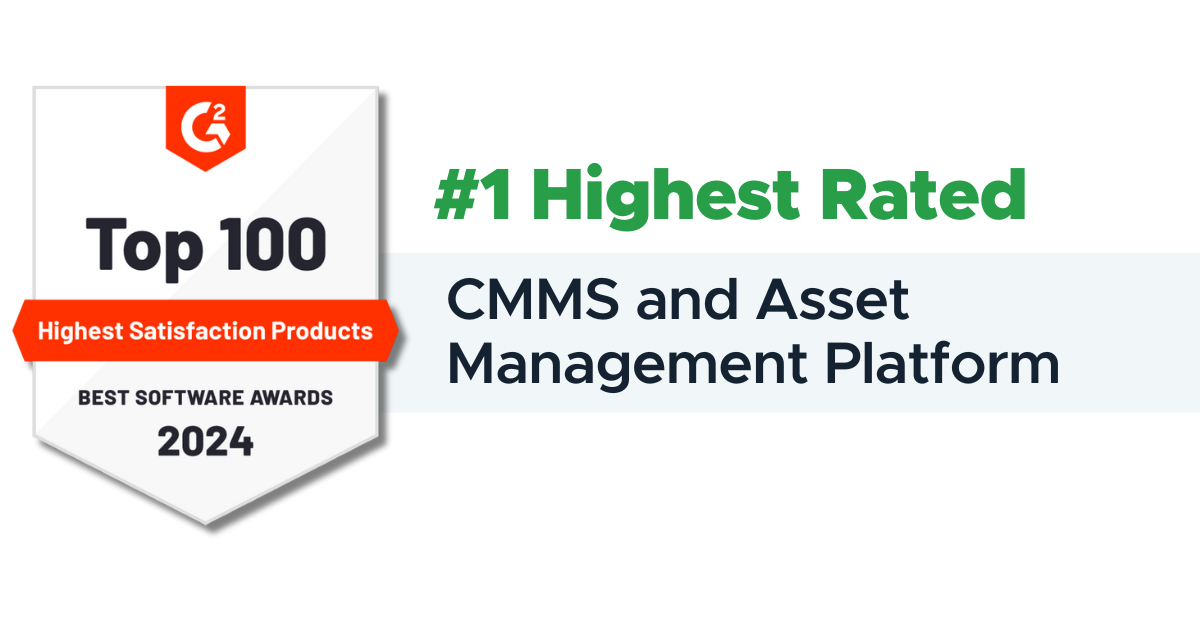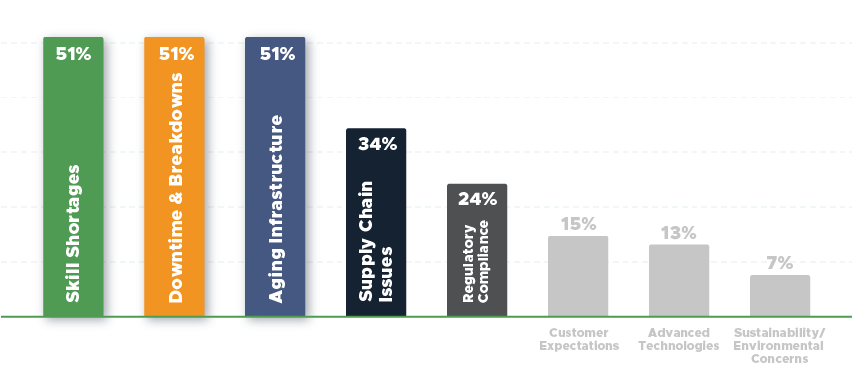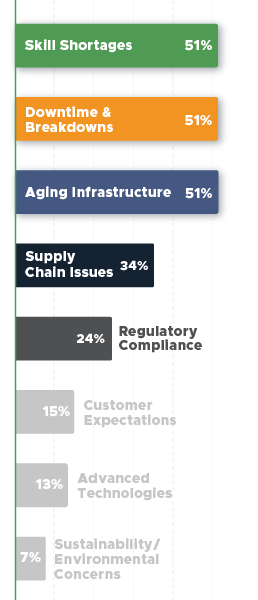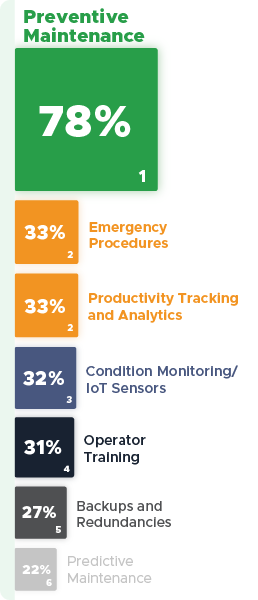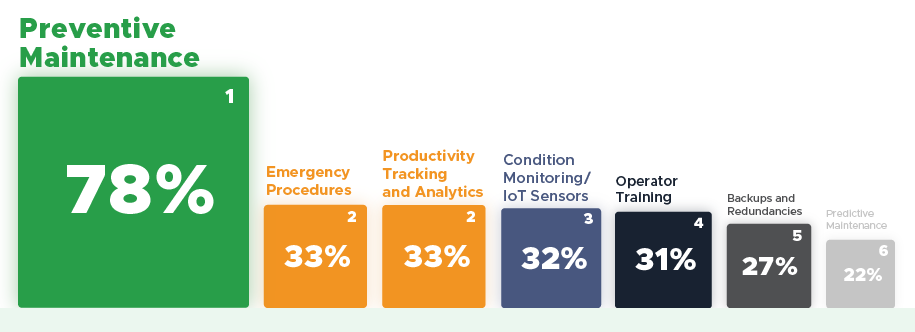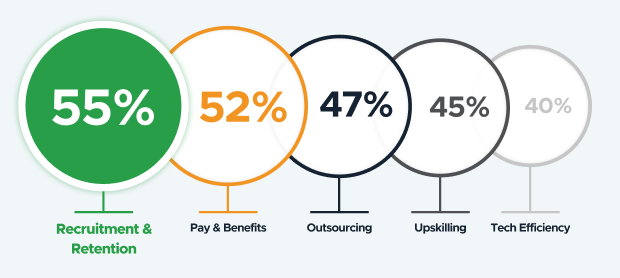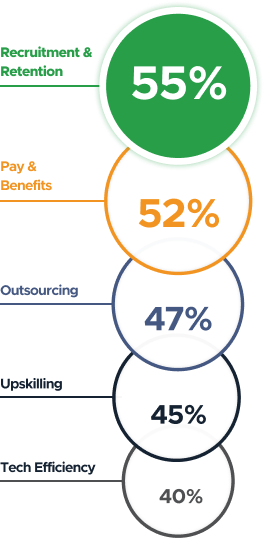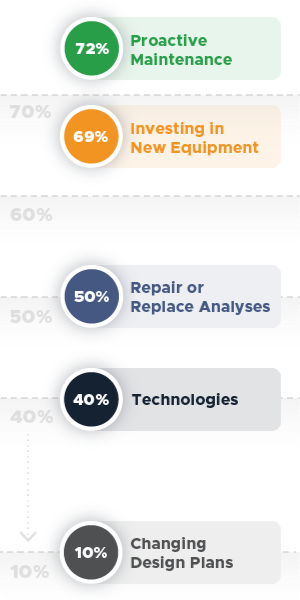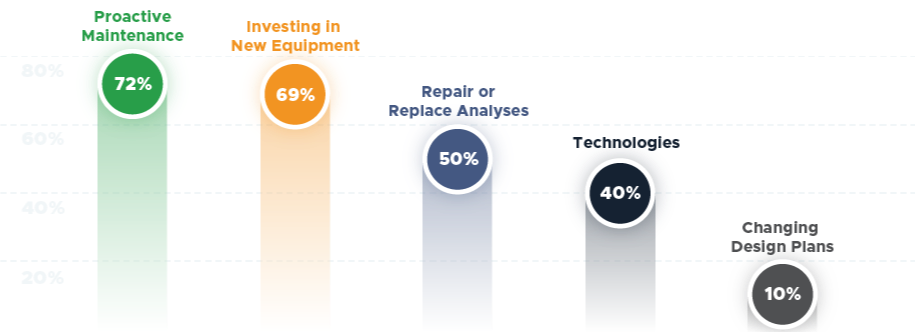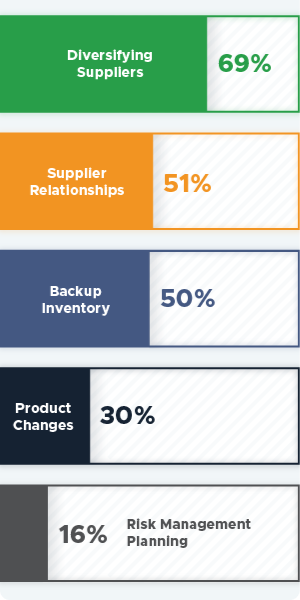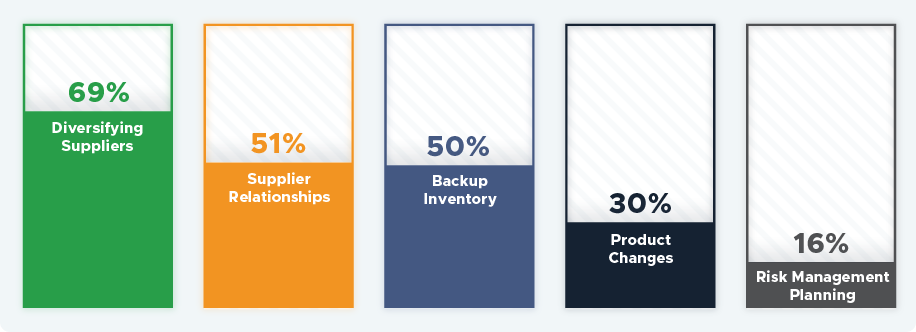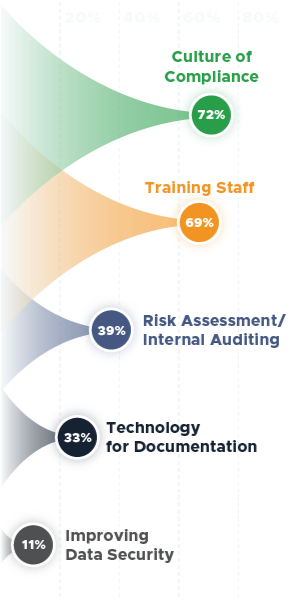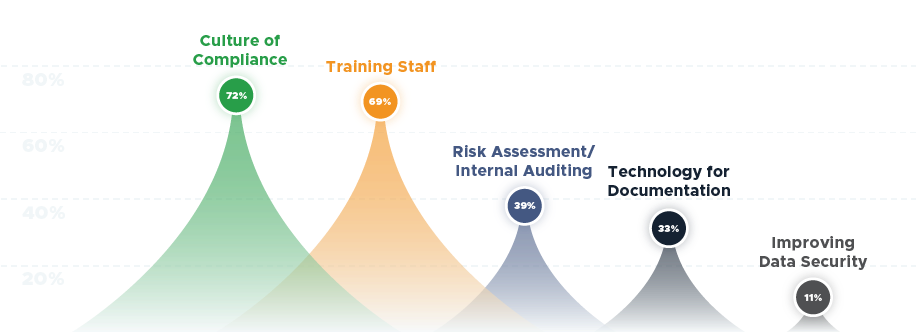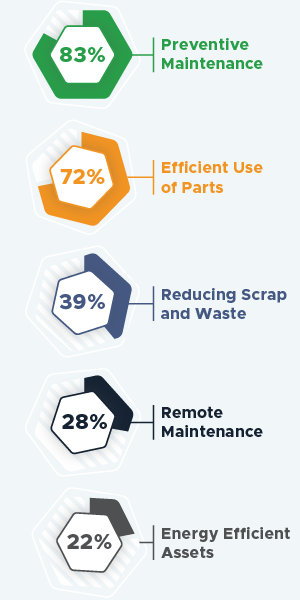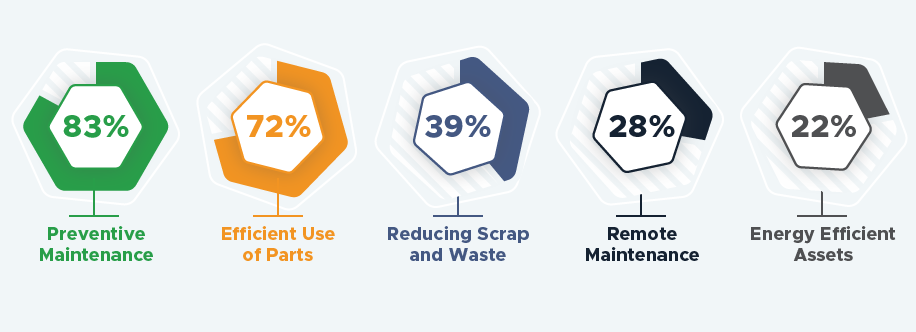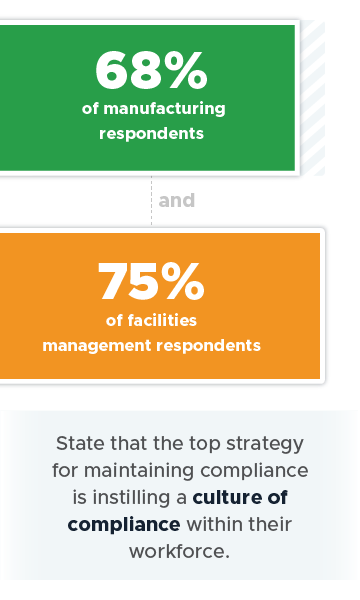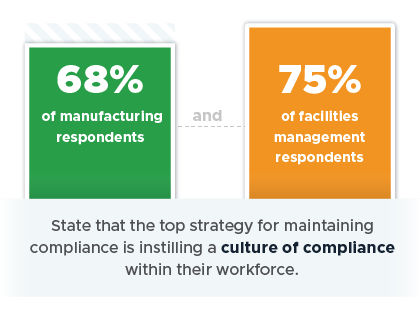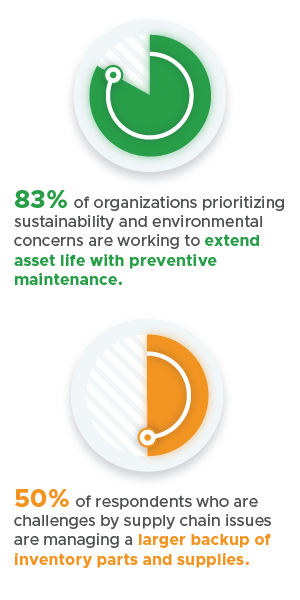2024 Industry Report The State of Maintenance in Manufacturing and Facilities
What's Inside?

01
Methodology
Everyone is talking about the next big thing: AI, emerging technologies, environmental sustainability, and more. But our recent survey of maintenance professionals shows the top challenges keeping operators and technicians up at night are far from new. They include:
- Reducing downtime
- managing and retaining a team
- and dealing with aging equipment and infrastructure
We’ll share our survey results and explain how these challenges differ by industry, what strategies organizations are using to address them, and what it all means for the future of the maintenance field.

Why we conducted the survey
The evolution of manufacturing maintenance has gained speed in recent years with the advent of ever-newer technologies. As predictions about… well… predictive technologies abound and AI emerges as the shiny new object, we here at Limble want to make sure we stay grounded in the here and now.
Change can happen quickly, but adopting and adapting to those changes can take time. We wanted to understand – outside of the hype around the next big thing – where maintenance teams find themselves amongst all the change. What challenges are truly impacting maintenance professionals? Where did they place their focus throughout 2023?


How we conducted the survey
As a software technology company that serves the maintenance industry, Limble is uniquely positioned with an extensive database of industry professionals and on-the-ground leaders. Limble surveyed 252 manufacturing and facility maintenance professionals to learn their top challenges.
Q. What are the top 3 challenges your company is facing?
For each challenge selected, respondents were then asked to indicate the top three strategies they were pursuing to address those challenges. Responses were anonymous and aggregated for analysis to identify trends and themes.
02
Results
More than half of respondents chose downtime, aging infrastructure, or workforce issues as one of their top three challenges. While many trends and new technologies are emerging, day-to-day concerns remain focused on uptime and productivity, maintaining or accommodating an aging infrastructure, and finding skilled workers to keep operations running.
From excessive downtime to workforce shortages, CMMS platforms help address common maintenance challenges.
02.1
Strategies
What steps are respondents taking to address these maintenance challenges?
Reducing Downtime
Machine downtime tied workforce shortages as the top challenge for maintenance professionals. And it makes sense. By keeping downtime under control, companies experience lower production costs, higher profits, and a more competitive position in the market. It also enhances overall equipment effectiveness, extending the lifespan of machinery and reducing the need for frequent repairs.
Minimizing downtime also allows for better responsiveness to consumer demands, fostering customer satisfaction and a positive brand reputation.
51.2%
Of respondents say this is one of their top three challenges
Prevention is far and away the focus of organizations hoping to reduce downtime. Respondents are supporting that initiative with numerous strategies, technologies, and analyses at relatively even rates.
Workforce Shortages
Workforce shortages continue to be a pain point for organizations across many industries. A lack of qualified staff hinders efficiency, productivity, product quality, and service by limiting the availability of skilled personnel for essential tasks. Overall, workforce shortages can significantly impact any organization’s ability to compete.
Survey respondents who were current users of Limble CMMS were significantly less likely to choose workforce shortages as a primary challenge than respondents who were not Limble customers – 45% of Limble customer respondents versus 66% of non-customers. Learn more about how a CMMS can help manage team shortages and evolving workforce trends.
51.2%
Of respondents say this is one of their top three challenges
It is no wonder why organizations report continued investment to close the gaps in their workforce. While recruitment & retention and pay & benefits play a big role in how all our survey participants are addressing this challenge, there are some differences based on industry.
Aging Infrastructure
Many countries have aging infrastructure in sectors such as transportation, energy, and water supply. Upgrading the infrastructure that is within their control in a financially sound way is crucial for organizations. It helps sustain reliable operations, eases the strain on logistics, helps meet industry regulations, and supports worker safety.
50.8%
Of respondents say this is one of their top three challenges
Proactive maintenance and investments in upgrades are the favored strategies to address aging infrastructure among our respondents. To make the most of these investments, strategic maintenance strategies supported by technology and data insights will take on an even more critical role.
Supply Chain Issues
Supply chain issues significantly impact organizations by disrupting the availability of critical tools, parts, and equipment. These disruptions can lead to breakdowns and extended downtime, reduced production efficiency, and skyrocketing maintenance costs.
34.1%
Of respondents say this is one of their top three challenges
When key supplies and equipment are delayed or unavailable, maintenance teams struggle to perform routine upkeep or promptly resolve unexpected breakdowns. To address these concerns, organizations are largely investing time and energy in developing more – and better – supplier relationships.
Regulatory Compliance Strategies
Industries such as healthcare, aviation, utilities, and manufacturing are subject to strict regulations. While not a top-three challenge for most of our survey respondents, for those impacted by it, regulatory compliance is non-negotiable. It requires careful documentation and rigorous adherence to processes and policies.
24.2%
Of respondents say this is one of their top three challenges
Overwhelmingly, the most leveraged resource companies use to ensure compliance is their own team. Improving staff awareness of compliance expectations through training, and reinforcing accountability through a culture of compliance ensures each team member’s function is performed with compliance in mind.
Sustainability and Environmental Concerns
The trend toward eco-friendly operations is appearing across industries. Sustainable business practices not only align with global environmental goals and regulatory requirements but also enhance brand reputation and attract environmentally conscious consumers. In addition, companies embracing green initiatives often experience cost savings through waste reduction, more efficient use of resources, and innovation.
7.1%
Of respondents say this is one of their top three challenges
However, the low rate of respondents choosing this item as a priority indicates that this issue has yet to infiltrate the daily operations and considerations of maintenance teams on a large scale.
The most commonly used strategies to improve sustainability fall squarely within the realm of maintenance. Bolstering asset life through preventive maintenance or making more efficient use of spare parts are the top strategies selected by respondents.
Ready to elevate, evolve, and empower your maintenance team with technology?


02.2
Industry-Specific Challenges
The manufacturing and facilities management industries face a variety of their own unique challenges. We dug into some of the most pressing trends for each. For manufacturing companies, the shift toward advanced technologies is required to remain competitive. For facilities managers, customer expectations are higher than ever before.
Manufacturing and the shift toward advanced technologies
Shifting toward advanced technologies has the potential to revolutionize manufacturing efficiency and innovation. Automation, robotics, and smart systems combined with data analytics and artificial intelligence enable predictive maintenance, minimizing downtime and maximizing equipment reliability. However, these advancements also introduce challenges of their own. Integrating emerging technologies into maintenance processes requires significant investment, unique skill sets, and sometimes changes in organizational culture.
How manufacturing teams are addressing the shift to advanced technologies
Advanced technologies have the potential to transform the manufacturing industry, but require a lot of data to be successful. That is why respondents prioritizing technology are shoring up their data collection and analysis capabilities. Machine sensors and IoT technology are important tools for the consistent and accurate data collection needed to leverage these strategies.
Improved Data and Analysis
Sensor-Enabled Maintenance
IoT Technology
Virtual and Remote Maintenance
Facility Management and shifting customer expectations
Facility managers are the most directly customer-facing members of the maintenance profession. Their role in receiving and responding to work requests means that customer service is an essential component of their work.
How facilities maintenance teams are addressing shifts in customer expectations
Respondents are overwhelmingly looking for tools and processes to improve work order management and communication with customers. Not only will these solutions help respondents meet customer expectations, but they will improve efficiency as well.
Improve WO Processes
Communications Tools
Data and Service Improvement
Customer Relationship Management
03
Takeaways
03.1
Predictions
So what do these survey results mean for a manufacturing industry that continues to focus on optimization and a facility management field in flux? Based on the responses from our survey participants and other trends in the maintenance field, here are our predictions for the year ahead.

Maintenance will take center stage
Manufacturers and facility managers that focus on more sophisticated maintenance strategies will have an edge. There will be an ongoing trend toward prevention and predictive analytics to address downtime and slow deterioration of aging equipment and facilities.
In 2024, we will see:
- Investments in maintenance that include equipment replacements, facility upgrades, technician training, and technology solutions.
- Facility managers favor preventive maintenance solutions and tools to improve response and repair times.
- Manufacturing leaders make maintenance a central function for broader areas of their workforce with autonomous maintenance initiatives.
- Use of data and new technologies to enable predictive maintenance and greater efficiency in production environments.
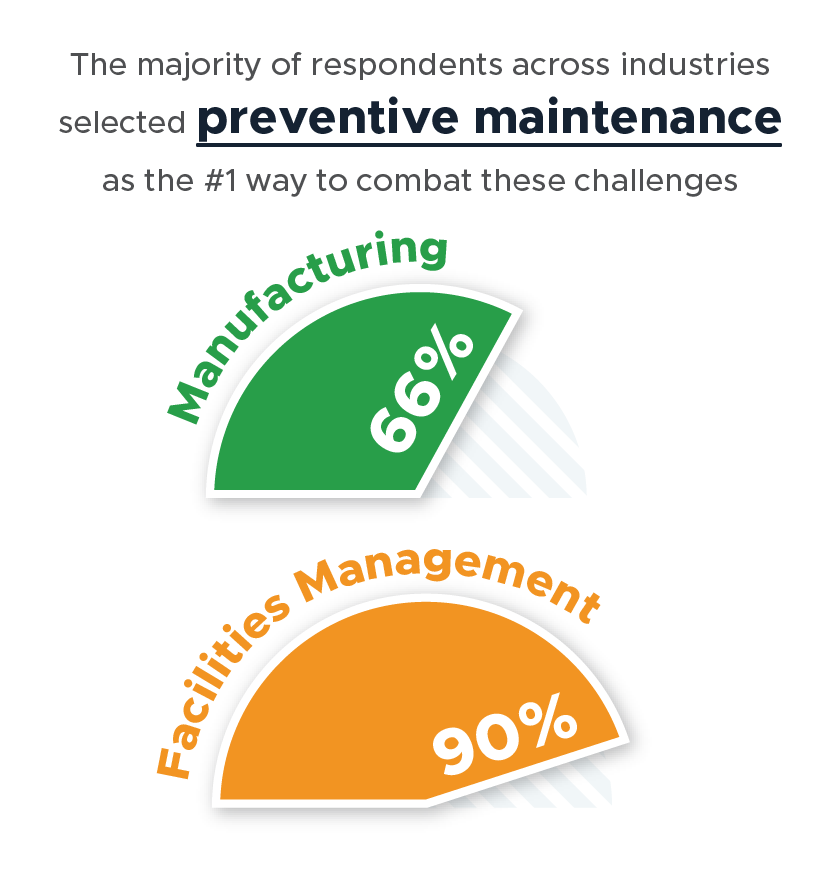


No options off the table to address workforce shortages
While workforce shortages remain a persistent issue in numerous industries, workforce trends in the field of maintenance present some unique challenges. That is why organizations will continue to make a variety of workforce initiatives a high priority in the next year.
Respondents in our survey are using a variety of tactics at relatively even rates. This demonstrates an understanding that there is no one-size-fits-all solution for resolving the shortage of skilled workers in critical manufacturing, facility management, and maintenance fields. Organizations that succeed will have well-rounded strategies that are sustained over the long term.

Organizations will leverage their workforce in new ways to address challenges
Speaking of workforce shortages, the skilled labor shortage has laid bare an important reality for many organizations: an engaged workforce is an organization’s most critical resource for success.
Survey responses show that organizations are engaging their workforce at high rates and in new ways to solve challenges such as regulatory compliance (through training and an accountable culture) and downtime (by elevating proactive and autonomous maintenance practices).

Spending to bolster maintenance and operations will be the norm
After years of emphasizing lean practices, there is a contrast emerging in our survey responses. The top strategies to address the most critical challenges selected in our survey involve serious investment in people, equipment, and infrastructure.
Increasing pay, benefits, and training to attract and upskill workers is a top strategy to alleviate workforce woes. A majority of respondents who are struggling with aging infrastructure will be upgrading their facilities and equipment to address it. And ensuring a larger backup inventory is a key solution to supply chain concerns.


The role of maintenance teams will continue to evolve
The cat is out of the bag and the days of maintenance being viewed solely as a necessary but undesirable expense are over. Organizations are realizing that the maintenance function – if leveraged and resourced strategically – can be a critical driver of efficiency and success.
Maintenance as an enabler of productivity
Effective preventive and predictive maintenance functions are being adopted more widely than ever and solutions to facilitate these approaches are becoming more accessible. This will help organizations reduce downtime and
drive productivity.
Maintenance as an internal technology pioneer
There are many new technologies on the horizon at any given moment. From AI to predictive analytics, maintenance is a great entry point for organizations to begin applying the most promising advancements.
Maintenance as a model for workforce and labor efficiency
The field of maintenance is no stranger to the “do more with less” mindset. Maintenance’s widespread shift toward proactive strategies and its adoption of efficiency-earning technology set an example for adding value to any organization.
03.1
Conclusion
The goal of our industry challenges survey was to understand the true day-to-day challenges that maintenance teams face. As an organization in service to the field of maintenance, staying aware of key challenges and the strategies maintenance teams are using to address them helps us provide better products and services to our current and future customers.
Our survey respondents are routinely implementing maintenance-centric solutions to their biggest challenges. Maintenance is driving higher productivity, promoting the adoption of advanced technologies, and uncovering novel methods for improving workforce efficiency. As the results and benefits begin to emerge, the role of maintenance will continue to evolve.
For maintenance professionals, the year ahead holds potential for innovation and growth.
The challenges will evolve and so will the solutions that creative maintenance teams use to solve them.
Limble cuts unplanned downtime, reduces the pain of workforce shortages, and streamlines regulatory audits
Book an exclusive 1-on-1 demo to see how Limble can help your maintenance team tackle top challenges
